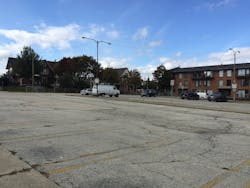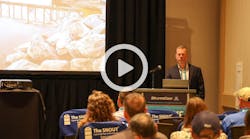About the author:
Alyssa Schmitt is senior project engineer for Stormwater Solutions Engineering. She can be reached at [email protected].
The Mitchell Street Green Parking Lot sits on Milwaukee, Wisconsin’s south side in the Historic Mitchell Street Neighborhood. The parking lot is unique in that it’s located on a watershed divide, draining between both the Menomonee and Kinnickinnic river watersheds, both of which lead to Lake Michigan. The parking lot is surrounded by an apartment building to the north, a parking lot to the east, a health care center and library to the south and 9th Street to the west. It was also connected to an alley that was essentially utilized as an extension of the parking lot. As a city of Milwaukee owned parking lot, they recognized that the parking lot was not only deteriorating and in poor condition but also a barren and under utilized impervious lot with increasing public safety hazards. With the support of its Environmental Collaboration Office, the city is striving to create a more sustainable, community-based space and saw the Mitchell Street Parking Lot as a perfect opportunity to pilot the idea of incorporating green spaces into city-owned parking lots.
Stormwater Solutions Engineering, LLC (SSE) was hired to perform the site design in 2018. When first assigned the project, the firm met to brainstorm site design concepts. After much deliberation, three separate concepts were conceived and proposed to the city. Each concept included various elements of green infrastructure, including bioswales and permeable pavement, as well as other design elements like benches, boardwalks and pockets of green spaces for pedestrians to safely navigate the parking lot and enjoy the outdoors. Because safety was also a goal, the city and the Business Improvement District enjoyed the ideas of reorienting the parking lot as well as converting the alley to a pedestrian mall. This allowed the firm to expand on its design ideas and change the flow of traffic to transform the alley into something that would enhance both storm water capture and the community space. SSE met with the client and other key stakeholders, walked through the concepts and created a final design, which ultimately incorporated a selection of green infrastructure elements from each plan.
SSE and the city of Milwaukee were able to leverage additional funding for green infrastructure improvements, along with the Wisconsin Coastal Management and the Milwaukee Metropolitan Sewerage District (MMSD), which provided funds through the Great Lakes Restoration Initiative and Fund For Lake Michigan. These funds helped to improve the alley and allowed the project team to use the space to engage and educate the community about the benefits of green infrastructure.
Stormwater Solutions Engineering worked closely with MMSD and the Sixteenth Street Community Health Center (SSCHC) to host a community meeting to walk key stakeholders and neighbors through the proposed project site. This allowed them to provide input on the project. Community engagement is especially important to foster a sense of pride and ownership over the spaces in their neighborhoods. They were given options on how they would prefer the alley to be constructed, what types of trees they would like to see onsite and influence on the color scheme. In the end, it was voted that the alley would be converted to a pedestrian mall that was designed to act as an urban orchard with fruit trees and storm water infiltration and storage in an underground stone storage layer beneath the native grasses that replaced the alley pavement. The portion of permeable pavement would be red brick to compliment the black park benches and tables throughout the site. The porous pavement was used as a novel approach to snow storage and related maintenance. The porous area was lined with an impermeable liner with underdrains directed to the combined (storm and sanitary) sewer, to prohibit the salt and sediment laden snowmelt from infiltrating into groundwater. Porous pavement joint stone filters out the sediment in the snow and then requires vacuum sweeping each spring.
The project went out to public bid, and C.W. Purpero Inc. was awarded the project. Construction began in spring of 2019, encountering a few bumps in the road along the way, in this case, water that had been trapped under the parking lot. The lot was originally a number of residential parcels pre-1950, and when the homes were razed, the foundations were filled in. This and the poor condition of pavement in the lot eventually caused water to become permanently trapped in the subsoil. This obstacle was discovered during construction, and it was determined the best solution would be to place an aggregate base on the existing sub-grade and then stabilize the soil with a cement layer. This essentially created a large, stabilized bridge between the unstable soil and the finished asphalt. With no other major hiccups, the project was successfully completed in late fall of 2019, and final educational signage will be installed in summer 2020.
The finished lot includes a 1,050 square-foot section of permeable pavement snow storage area. It also includes four bioswales totaling 3,100 square-feet, and an additional 4,100 square-feet of green space. Overall, the site captures 132,000 gallons of water and can hold a 25-year storm and safely pass the 100-year storm. It incorporates ADA accessible parking, safe pedestrian routes via brick pavers and a wooden boardwalk with wood sourced locally from the Menomonee Tribal Enterprises, directly connecting to the relationship with the Ignace Indian Health Center located just south of the lot. There are now park benches and tables placed throughout the site so pedestrians can enjoy an oasis of green space in the middle of the city. There is safe connectivity throughout the lot with improved lighting and safety aspects, and it is the perfect place to sit and grab a book from the library while enjoying a pear and some cherries from the urban orchard. This project serves as a beautiful example on how more holistic and sustainable approaches to traditional engineering projects can achieve a greater community impact.


